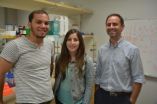(Press-News.org) Old World monkeys have undergone a remarkable evolution in facial appearance as a way of avoiding interbreeding with closely related and geographically proximate species, researchers from New York University and the University of Exeter have found. Their research provides the best evidence to date for the role of visual cues as a barrier to breeding across species.
"Evolution produces adaptations that help animals thrive in a particular environment, and over time these adaptations lead to the evolution of new species," explains James Higham, an assistant professor in NYU's Department of Anthropology and the senior author of the study, which appears in the journal Nature Communications. "A key question is what mechanisms keep closely related species that overlap geographically from inter-breeding, so that they are maintained as separate species.
"Our findings offer evidence for the use of visual signals to help ensure species recognition: species may evolve to look distinct specifically from the other species they are at risk of inter-breeding with. In other words, how you end up looking is a function of how those around you look. With the primates we studied, this has a purpose: to strengthen reproductive isolation between populations."
The study's lead author was William Allen, who undertook the work while a post-doctoral researcher in NYU's Department of Anthropology. The researchers studied guenons—a group of more than two dozen species of monkeys indigenous to the forests of Central and West Africa. Many different species of guenons are often sympatric—they live in close proximity to each other, with multiple species often traveling, feeding, and sleeping side-by-side. Therefore interbreeding, which could result in afflicted infertile offspring, remains an unwelcome possibility.
In the 1980s, Oxford zoologist Jonathan Kingdon tried to explain the diversity in facial appearance of guenons, which show markings such as differently colored eyebrow patches, ear tufts, nose spots, and mouth patches. He hypothesized that sympatric guenon species had undergone facial changes that visually reinforced differences among their species in order to avoid the risks of hybridizing.
However, Kingdon's ideas were primarily based on observations with the naked eye, and he failed to find evidence for his hypotheses. The NYU and University of Exeter scientists sought to test Kingdon's conclusions quantitatively using sophisticated methods—facial recognition algorithms that can identify and quantify detailed features in faces.
To do this, they photographed nearly two dozen species of guenons in various settings, over an 18-month period: in zoos in the United States and the United Kingdom and in a wildlife sanctuary in Nigeria. Armed with more than 1,400 standardized photographs, the researchers employed what is known as the eigenface technique, which has been used in the field of computer vision for machine recognition of faces, in order to distinguish primate features and then to determine whether the appearance of each guenon species was related to the appearance of other species.
Their results showed that, as predicted, the face patterns of guenon species have evolved to become more visually distinctive—specifically from those guenon species they overlap with geographically—and hence those that they are risk of hybridizing with.
"These results strongly suggest that the extraordinary appearance of these monkeys has been due to selection for visual signals that discourage hybridization," observes lead author Allen, now at the University of Hull. "This is perhaps the strongest evidence to date for a role for visual signals in the key evolutionary processes by which species are formed and maintained, and it is particularly exciting that we have found it in part of our own lineage."
INFORMATION: END
To avoid interbreeding, monkeys have undergone evolution in facial appearance
2014-06-26
ELSE PRESS RELEASES FROM THIS DATE:
A breakthrough for organic reactions in water
2014-06-26
Green-chemistry researchers at McGill University have discovered a way to use water as a solvent in one of the reactions most widely used to synthesize chemical products and pharmaceuticals.
The findings, published June 26 in Nature Communications, mark a potential milestone in efforts to develop organic reactions in water.
Chao-Jun Li and Feng Zhou of McGill's Department of Chemistry report that they have discovered a catalytic system which for the first time allows direct metal-mediated reactions between aryl halides and carbonyl compounds in water.
For the past ...
Research says TB infection may be underestimated among people taking corticosteroid pills
2014-06-26
TORONTO, June 26, 2014—Tuberculosis infection among people taking corticosteroid pills may be underestimated, new research suggests. Current guidelines for what constitutes a positive TB skin test among corticosteroid pill users may not be capturing all those who are infected, said Dr. Nicholas Vozoris, a respirologist in the Tuberculosis Program at St. Michael's Hospital.
Previous research has shown that people who take corticosteroid pills, such as Prednisone, and have inhaled the TB bacteria, have an eight times higher risk of the bacteria becoming active than people ...
Men and women use mental health services differently
2014-06-26
TORONTO, June 26, 2014 – Women with chronic physical illnesses are more likely to use mental health services than men with similar illnesses; they also seek out mental health services six months earlier than those same men, according to new study from St. Michael's Hospital and the Institute for Clinical Evaluative Sciences (ICES).
"Chronic physical illness can lead to depression," said Dr. Flora Matheson, a scientist in the hospital's Centre for Research on Inner City Health. "We want to better understand who will seek mental health services when diagnosed with a chronic ...
Continued use of low-dose aspirin may lower pancreatic cancer risk
2014-06-26
PHILADELPHIA — The longer a person took low-dose aspirin, the lower his or her risk for developing pancreatic cancer, according to a study published in Cancer Epidemiology, Biomarkers & Prevention, a journal of the American Association for Cancer Research.
"We found that the use of low-dose aspirin was associated with cutting the risk of pancreatic cancer in half, with some evidence that the longer low-dose aspirin was used, the lower the risk," said Harvey A. Risch, MD, PhD, professor of epidemiology in the Department of Chronic Disease Epidemiology at the Yale School ...
Revisions needed for current IV feeding safeguards against bloodstream infections
2014-06-26
Current guidelines to help prevent bloodstream infections during intravenous feeding may need
revisions to strengthen protections for patients, a new study finds.
Researchers at the United Kingdom's University of Southampton found that current guidelines do not account for other independent factors that can affect the growth of potentially deadly microorganisms. Their study was published today in the OnlineFirst version of the Journal of
Parenteral and Enteral Nutrition (JPEN), the research journal of the American Society for Parenteral and Enteral Nutrition (A.S.P.E.N.). ...
Researchers call for patients who receive home nutritional care to have emergency plans
2014-06-26
On the heels of the 2014 hurricane season, researchers are calling for home parenteral and enteral nutrition (HPEN) consumers and their homecare providers to have a comprehensive emergency preparedness plan (EPP) to ensure that special needs are met during the time of a disaster.
In a paper published today in the American Society for Parenteral and Enteral Nutrition's (A.S.P.E.N.) Nutrition in Clinical Practice journal, researchers with Coram Specialty Infusion Services outline the experiences of HPEN consumers and homecare providers in New Jersey affected by Hurricane ...
Researchers discover 'Trojan Horse' method of penetrating cellular walls without harm
2014-06-26
COLLEGE STATION – Scientists with Texas A&M AgriLife Research have found a "Trojan horse" way to deliver proteins into live human cells without damaging them.
The finding, published in this month's Nature Methods, is expected to be easily adopted for use in medical research to find cures and treatments for a wide range of diseases, according to the team's lead scientist, Dr. Jean-Philippe Pellois, an associate professor of biochemistry at Texas A&M University.
"This is something that for many years people have tried to do, because proteins are basic components of the ...
Invasive watersnakes introduced to California may pose risk to native species
2014-06-26
Watersnakes, commonly seen in the lakes, rivers and streams of the eastern United States, are invading California waterways and may pose a threat to native and endangered species in the state, according to a University of California, Davis, study.
While scientists do not know exactly how many watersnakes are in California, roughly 300 individuals of two different species –the common watersnake and the southern watersnake -- have been found in the Sacramento area (Roseville and Folsom), and at least 150 were seen in Long Beach. Researchers suspect the nonvenomous snakes ...
Sequencing efforts miss DNA crucial to bacteria's disease causing power
2014-06-26
Genomic sequencing is supposed to reveal the entire genetic makeup of an organism. For infectious disease specialists, the technology can be used to analyze a disease-causing bacterium to determine how much harm it is capable of causing and whether or not it will be resistant to antibiotics. But new research at Rockefeller University suggests that current sequencing protocols overlook crucial bits of information: isolated pieces of DNA floating outside the bacterial chromosome, the core of a cell's genetic material.
"Extensive sequencing of chromosomal DNA has been performed ...
A win-win-win solution for biofuel, climate, and biodiversity
2014-06-25
Fossil fuel emissions release billions of tons of carbon into the atmosphere each year, which is changing the climate and threatening the sustainability of life on planet Earth. In Brazil, the demand for alternative energy sources has led to an increase in biofuel crops. A new "News and Views" paper in Nature Climate Change, co-authored by Woods Hole Research Center scientists Marcia Macedo and Eric Davidson, reviews new research conducted by Brazilian colleagues demonstrating the high carbon costs of converting intact Brazilian savanna compared to the carbon gains obtained ...


